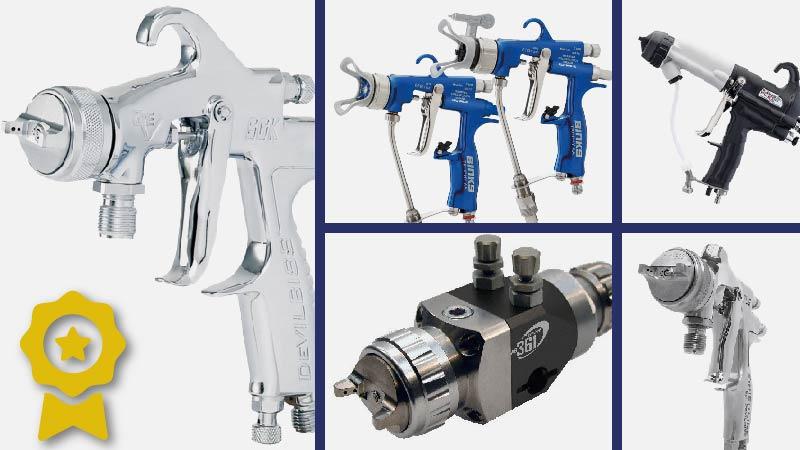Spray guns for wood finishing vary greatly according to the technology in place. For that reason, you cannot just grab your spray gun for automotive to paint wood. There is not a one-size-fits-all solution.
So, in this article we are going to explain why they are different, but most importantly, we will share with you 5 spray guns for wood chosen by experts in industrial finishing.
Why are special spray guns for wood finishing needed?
There are four key reasons why specialized spray guns for wood finishing are recommended. Let’s now consider each one of these reasons.
Wood and metal are different as a surface
There are several key differences between wood and metal as a surface. They require different coatings and painting technology.
Composition: Wood is an organic, porous material composed of cellulose fibers. Metals are inorganic, non-porous materials that are mined or extracted.
Structure: Metals have a crystalline molecular structure while wood has a fibrous grain structure. The grains and patterns in wood are unique to each piece.
Hardness: Most woods are softer than metals. On the Janka hardness scale, oak is about 1,300 lbs while stainless steel is around 5,800 lbs (about 2,630.83 kg). Some exotic woods approach the hardness of softer metals.
Stability: Wood shrinks/swells and can warp with changes in moisture and humidity. Metals are dimensionally stable and unaffected by humidity or moisture.
Thermal properties: Wood is a poor conductor of heat compared to metals which readily conduct heat. Metals feel cold to the touch unlike wood.
Finishing: Wood requires more prep work and finishing like sanding and staining to achieve a smooth appearance. Metals just need cleaning.
Weather resistance: When unfinished, wood deteriorates when exposed to weather. Metals resist weathering and oxidize or corrode minimally.
Environmental impact: Wood is a renewable resource but metals require mining and refining which can generate pollution.
So, in a few words, regarding painting, the porous, fibrous, softer, less thermally conductive nature of wood and its instability require more preparation and finishing compared to metals.
The coatings used for wood finishing
The coatings used for wood vary greatly from those used for, let’s say, automotive refinishing. Here are some of the most common types of coatings used to paint or finish wood:
Stains: Used to accentuate the natural wood grain. Come in oil-based, water-based, gel stains. They need a top clear protective coat.
Oil-based paints: Provide a smooth, durable glossy finish. Typically contain alkyd resins. Require mineral spirits for cleanup.
Water-based paints: Based on latex or acrylic. Easy soap and water cleanup. Less odor than oils. Not as durable.
Lacquer: Derived from nitrocellulose. Dries to a very smooth, durable finish. Spray on easily. Requires lacquer thinner to clean.
Shellac: An alcohol-based resin secreted from the lac beetle. Classic wood finish. Dries quickly. Requires denatured alcohol to thin and clean.
Varnish: Alkyd resins suspended in oil. Forms a hard, protective clear finish. Requires mineral spirits.
Polyurethane: Plastic-like protective clear coat. Oil-based or water-based versions. Resistant to scratching and marring.
Milk paint: Water-based paint made from milk protein, lime, and pigment. Natural, flat finish. Non-toxic.
Exterior paints and stains: Formulated similarly to regular paints and stains, but with additives designed to made the wood withstand weathering. Often oil or latex based.
Summarizing this up, oil-based paint, lacquer, shellac, varnish and polyurethane are good options for durable wood finishes. Water-based acrylics work for indoor projects. And stains allow the natural wood to show through.
The type of projects for wood finishing
Here are some common woodworking projects that typically require some type of finishing or protective coating:
Interior Furniture: Tables, chairs, beds, dressers, etc. Usually they need stains, paints, varnishes or polyurethanes to protect the wood and provide the desired look.
Exterior Furniture: Benches, chairs, picnic tables, etc. benefit from exterior paints, stains, varnishes. Since they are exposed to the elements, they need an especial coating that can make them last longer.
Cabinets: Built-in cabinets for kitchen and bathrooms. They need durable finishes like polyurethane or conversion varnish to protect from moisture and spills.
Doors: Interior and exterior doors are often painted, stained or varnished. They need protection from weathering or wear.
Trim/Crown Molding: Requires paint or stain to match the room decor. Polyurethane for a durable finish.
Flooring: Hardwood flooring is finished with polyurethane or specialty floor finishes.
Decks: Need weather-resistant exterior stains or paints designed for wood decking.
Paneling: Often stained to match the room colors. Polyurethane adds durability.
Crafts: Painting, staining or decorating wood crafts like bird houses, jewelry boxes.
Tools: Painting the handles or staining wood tool handles.
Boats: Marine grade finishes to protect wood boats from water damage.
Any bare wood that needs protection from elements, wear and tear, or wants an aesthetic finish needs some type of coating. The right choice depends on use and desired look. They right spray gun for wood plays a singular role in giving them the desired look.
How the coatings are applied
The final reason why especial spray guns for wood might be needed is how the coatings are applied. Let’s see this in more detail.
Fine finish: Wood requires an extremely smooth, even finish to look good whether stained, painted or clear coated. HVLP spray guns are designed to apply very fine mists for smooth results.
Control: The irregular grains and patterns in wood need controlled application of stains, paints or clear coats. Adjustable fluid and air mix on good spray guns for wood allows this.
Reduced overspray: HPLV guns minimize bounce-back and overspray which could stain or paint surrounding areas. This preserves detailed work.
Flexible spray patterns: Spray guns for wood finishing allow adjusting the fan pattern from wide to narrow to accommodate different projects.
Flow adjustment: Controlling the fluid flow rate helps prevent sags, runs and other flaws in the wet coating on vertical wood surfaces, like when painting wood doors.
Spraying undiluted coatings: Many wood coatings can be sprayed undiluted for maximum durability so guns must accommodate thicker fluids.
Easy cleaning: Quick access to cleaning needles and ease of disassembly makes cleaning wood finishing spray guns simpler.
Durability: Good quality spray guns for wood are made to hold up under heavy use over time without leaks, sputters or clogs during critical finishing work.
The right spray gun for wood helps achieve beautiful, professional finishes efficiently while also saving time and minimizing waste of expensive coatings. That being said, let’s now take a look to 5 spray guns for wood selected for a group of experts.
5th place: DeVilbiss FLG-515
The FLG-515 is a high-quality pressure feed spray gun made by DeVilbiss for industrial finishing applications. The FLG-515 has an excellent reputation for atomization, reducing orange peel, minimizing overspray.
The FLG-515-P11 and FLG-515-P14 are high production HVLP-Transtec spray guns fed by pressure tank or double diaphragm pump. HVLP-Transtec technology provides paint savings by reducing waste and contamination with the advantage of consuming less air volume.
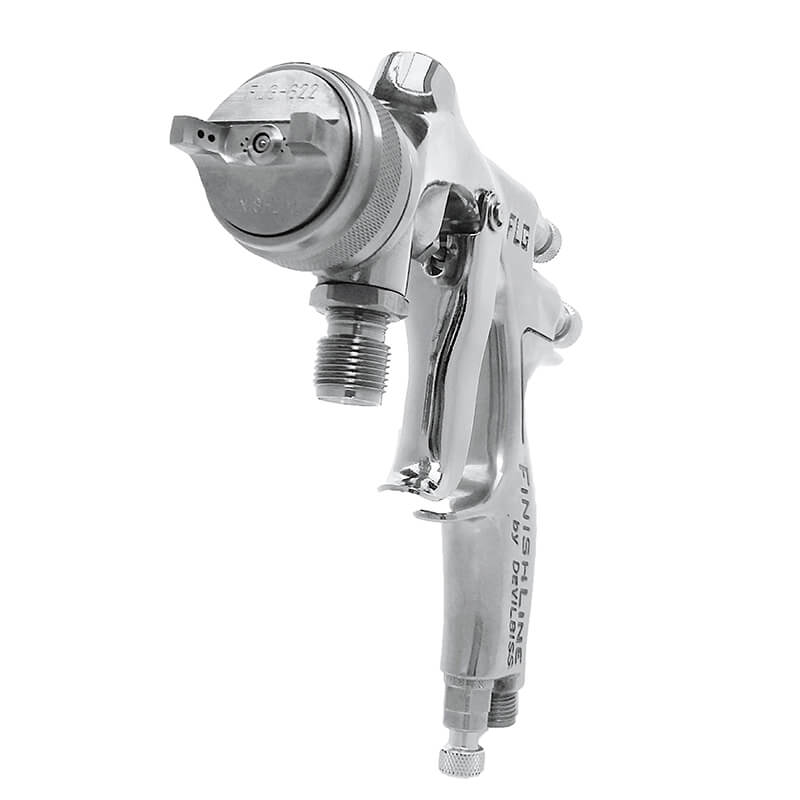
Devilbiss FLG-515 Main Features
- It is a lightweight, yet rugged spray gun body made from aluminum and stainless steel
- Comes with a 1 liter aluminum siphon cup and fluid tip and needle
- Operates at atomizing pressures between 29 – 50 PSI
- It has air and fluid adjusters to control and fine tune the spray pattern/flow
- It can be used for spraying primer, paint, clear coat, stains, etc.
- Provides a consistent spray fan ranging from 1″ to 16” across
- Available with different sized fluid tips – 1.1, 1.4 mm.
- Easy to disassemble and clean when done spraying
So in summary, it is a versatile, professional-grade pressure feed spray gun great for the demands of automotive and industrial finishing work.
Devilbiss FLG-515 Technical Features
- Nozzle / Needle: 1.1 mm (model FLG-515-P11) and 1.4 mm (model FLG-515-P14)
- Air Consumption: 11 to 13.5 cfm at 45 PSI
- Ink Flow: 300 to 840 ml / minute
- Inlet Pressure: 35 to 45 PSI
- Fan Pattern: 13″ to 16″ at a distance of 9″
- Weight (gun only): 485g
- Gun Body: Aluminum
- Air Cap : Plated Brass
- Air Cap Retaining Ring & Knobs: Clear Anodized Aluminum
- Fluid Nozzle: Stainless Steel
- Fluid Needle: Stainless Steel
- Air Inlet Thread: 1/4” Universal
What are HVLP spray guns?
HVLP stands for High Volume Low Pressure. As the name indicates, these operate at lower air pressures, resulting in less overspray and more efficient paint transfer. They provide good control over the spray pattern and are commonly used for overall painting, blending, and detailing work.
4th place: Binks Trophy AA Series
The Binks Trophy AA Series is formed by the models AA1600 & AA4400. They are two high pressure Air Assisted Airless Manual Spray Guns. Designed to handle the toughest of applications, the Binks Trophy AA Series are built to maximize spray quality, increase efficiency, reduce downtime and be environmentally responsible, while providing the lightweight, ergonomically sculpted fit and feel that operators demand.
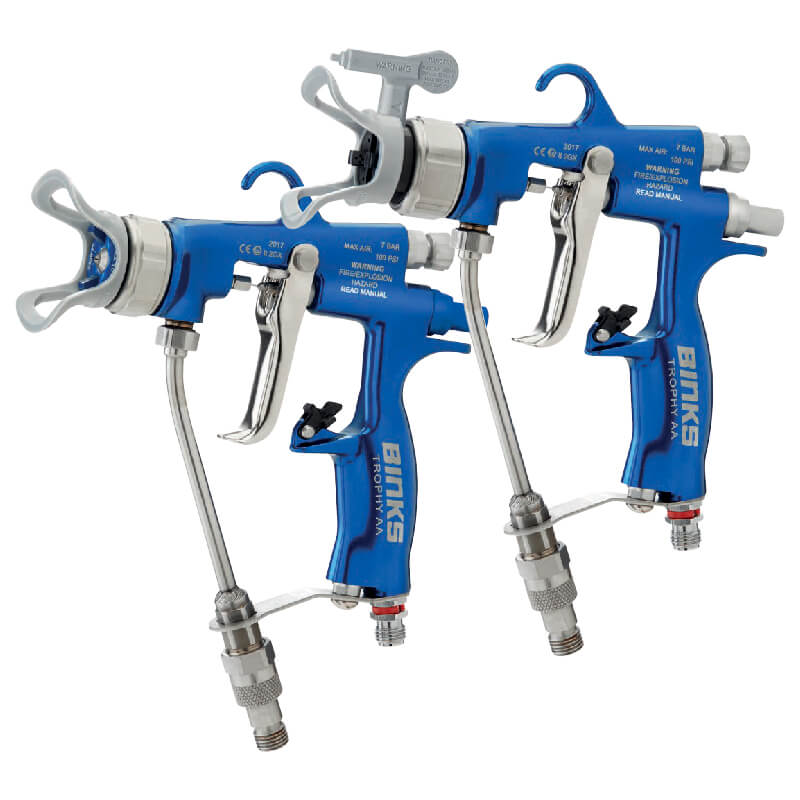
Two models: AA1600 and AA4400
The new Binks Trophy AA combines industry experience, design, and technology in our all-new Air Assisted Airless spray gun. A new range of AA10+ Air Caps as well as an innovative replaceable tip seal, places the Binks Trophy AA firmly at the fore-front of Air Assisted Airless spray gun design. Having a low trigger-force enhances control while significantly reducing operator fatigue and the chances of RSI.
Suitable for these materials:
- Solvent or Waterborne Coatings
- Stains varnishes and lacquers
- Inks and dyes
- Sealers and undercoats
- Synthetic and enamel paints
Binks Trophy AA Series Main Features
- Lightweight air assisted airless spray gun
- High quality atomization for industry leading finish
- Solid forged gun body for maximum durability and longer life
- Quick-CleanTM gun coating for fast cleaning and maintenance
- Wide selection of flat, fine-finish and twist tips available
- It does not require a separate air compressor, but the paint is atomized hydraulically
- It has a heavy duty all stainless steel body for durability
- Uses a dual piston pump that can spray 0.25 to 0.60 gallons per minute
- Designed to spray a wide range of coatings – lacquers, enamels, urethanes, epoxies
- Excellent for wood, metal, plastic, cement and other surfaces
- It can support tip sizes from .011 to .025 for desired spray patterns
- Easy access design makes routine maintenance simple
- Equipped with BlueLink controller for monitoring pressure and fluid flow
- Provides a very high transfer efficiency up to 80% with minimal overspray
Binks Trophy AA Series Technical Features
| Feature | Trophy AA 1600 | Trophy AA 4400 |
|---|---|---|
| Maximum fluid pressure | 1,600 psi (110 bar) | 4,400 psi (303 Bar) |
| Maximum air inlet pressure | 105 psi (7 bar) | 105 psi (7 bar) |
| Gun Body material | Forged Aluminum | Forged Aluminum |
| Fluid Path material | Stainless Steel | Stainless Steel |
| Fluid Seat Material | PEEK | Tungsten Carbide |
| Fluid inlet connection | 1/4” NPS (m) | 1/4” NPS (m) |
| Air inlet connection | 1/4” BSP / NPS (m) | 1/4” BSP / NPS (m) |
So in summary, the Binks Trophy AA Series are a heavy-duty, high performance airless spray gun suitable for the toughest industrial coating applications. It provides professional-quality finishes.
What are airless spray guns?
These use hydraulic pressure instead of compressed air to atomize the paint. They have very little overspray and can apply thicker coatings than other guns.
They are not widely used in automotive refinishing, but mostly for wood finishing. They are mainly used for primers, single stage paints, and high build clears.
3rd place: DeVilbiss AG360 Series Automatic Spray Guns
The DeVilbiss AG-360 Series are low pressure automatic spray guns available in various spray gun formats to provide an all-encompassing and universal automatic finishing solution for all applications.
Designed to function in the tough working environment of the modern finishing industry, these spray guns give you maximum productivity with minimum downtime. They are a professional spray equipment for universal superior performance.
Using the acknowledged market leading low pressure air atomization technology from DeVilbiss, the AG-360 series has been developed to provide a blend of finish quality, engineering robustness and superior transfer efficiency.
The AG-360 series from DeVilbiss is available in various gun formats to provide an all encompassing and universal automatic finishing solution for all applications, wood finishing included. Designed to function in the tough working environment of the modern finishing industry, these automatic spray guns give you maximum productivity with minimum downtime.
A comprehensive range of conventional, HVLP and Trans Tech (Compliant) air caps provide a choice of environmental compliance, transfer efficiency, atomization power and application requirements.
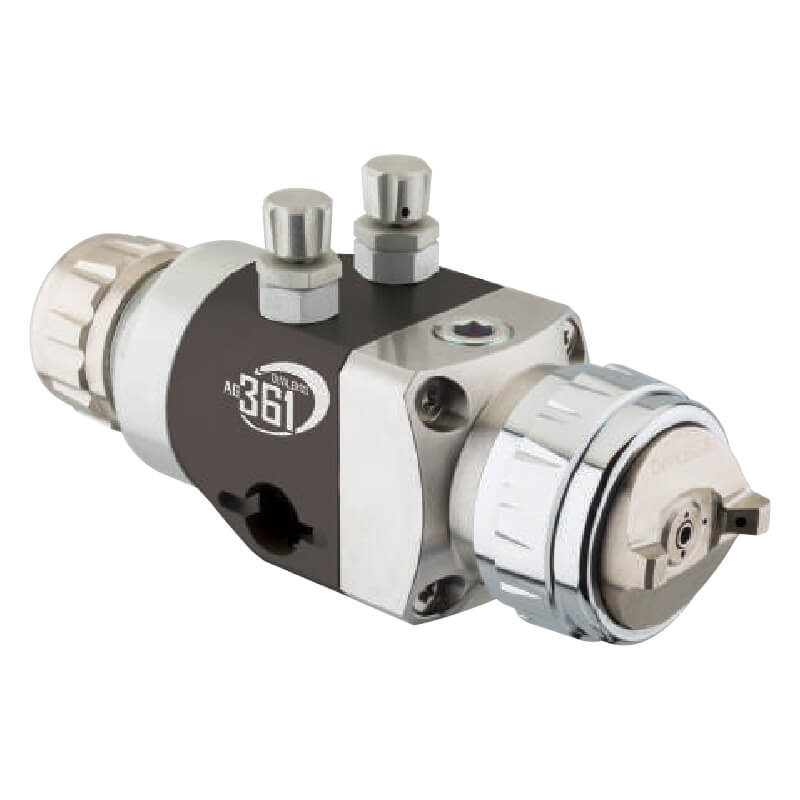
Typical coating types and applications
- Solvent and Water Based Paints and Materials
- Wood sector Stains, Sealers and Topcoats
- Adhesives and Glues
- Ceramics, Enamel and Glaze
- Epoxy Primers and Polyurethane Top coats
- Air drying, stoving and 2K coatings
- UV and radiation cured finishes
Typical Mounting
- Rotary & Carousel Machines
- Reciprocators & Tranverse equipment
- Robot & complex gun movers
- Fixed spray stations
DeVilbiss AG-360 Series Main Features
- Simple construction and easy maintenance for minimal down-time
- Stainless steel fluid passageways for water based & solvent based coating applications
- Quick detachable mounting manifolds provide fast and easy maintenance
- Compact size and weight for easy positioning and precise alignment
- Multiple options and formats to evolve for all application requirements
- Independent fan, atomizing and trigger air – vital for robotic and fully automatic machine applications
DeVilbiss AG-360 Series Technical Features
| Feature | Parameter |
|---|---|
| Max Air Input Pressure (P1) | 7 bar |
| Max Fluid Input Pressure (P2) | 7 bar |
| Max Operating Ambient Temperature | 40°C nominal |
| Gun Head & Fluid Passageways | Stainless Steel |
| Gun Body Material | QuickClean™ coated Aluminium |
| Manifold Material | Stainless Steel |
| Fluid Nozzle & Needle Materials | 303 Stainless Steel, Nitride coated Stainless Steel, Tungsten carbide |
| Seals & O rings | HDPE, FEPM, PTFE, FFKM |
| Spray Gun Dimensions & Weights | |
|---|---|
| AG-361 Size (L x H x W) mm | 140 x 67 (inc valves) x 44 |
| AG-361 Weight | 668 g (inc air cap) |
| AG-362 Gun Size (L x H x W) mm | 122 x 44 x 44 |
| AG-362 (Gun only) Weight | 557 g (inc air cap) |
| AG-362P Size (L x H x D) mm | 145 x 44 x 44 |
| AG-362P (Gun only) Weight | 524 g (inc air cap) |
| Manifold Dimensions & Weights | |
|---|---|
| Cam Manifold Size (L x W x H) mm | 60 x 44 x 53 (inc valves) |
| Cam Manifold Weight | 347 g |
| Screw Manifold Size (L x W x H) mm | 59 x 63 (inc valves) x 20 |
| Screw Manifold Weight | 268 g |
| AG-361 Industrial & Enamel Guns | |
|---|---|
| CYL Air inlet connection | 1/8 ” G |
| Fluid Inlet connection | 1/4 ” G |
| CAP Air Inlet connection | 1/4 ” G |
| AG-362L Lever Manifold | |
|---|---|
| CYL Air inlet connection | 1/8 ” G |
| Fluid Inlet connection | 1/8 ” G |
| Fluid Outlet connection | 1/8 ” G |
| ATOM Air inlet connection | 1/8 ” G |
| FAN Air inlet connection | 1/8 ” G |
| AG-362S Screw Manifold | |
|---|---|
| CYL Air inlet connection | 1/8 ” G |
| Fluid Inlet connection | 1/4 ” NPS |
| Fluid Outlet connection | 1/4 ” NPS |
| CAP Air inlet (ATOM+FAN) | 1/4 ” G |
What are automatic spray guns?
Automatic spray guns refer to systems that are programmed and operated by machines, robots, or other automated means rather than being handheld and manually controlled.
Multiple automatic spray guns can work simultaneously on large production pieces. They are attached to robotic arms, reciprocators, or other programmable machinery to direct the spray motion. This allow consistent, high-quality finishes with incredible precision and repeatability.
In general, automatic spray guns offer efficiency, speed and consistency for industrial finishing needs. But manual spray guns still offer more flexibility and control for small jobs.
Automatic spray guns are used for high volume production line painting and coating such as in automotive, appliance, and furniture finishing.
2nd place: Ransburg Ransflex
The Ransburg RansFlex is an electrostatic spray gun, meaning it imparts an electrical charge to the coating as it is atomized. The charged coating particles are attracted to the grounded workpiece, providing more efficient transfer and wrap around hard to reach areas.
This electrostatic spray gun integrate the best of both worlds: Ransburg® electrostatics with the legendary DeVilbiss atomization technology. Smaller and lighter-weight RansFlex RX and RFX applicators feature enhanced, proprietary cascade and atomization technology. These advancements provide a compact applicator with the equivalent or better performance and transfer efficiency of higher voltage competitive spray guns.
The RansFlex Quick Fan Adjust applicator is an air atomizing electrostatic applicator powered by an onboard generator that provides best in class atomization in a lightweight, user friendly applicator. The RFQ and RFQX both offer superior finish quality surpasses competitor’s larger, higher voltage applicators in small compact size.
The new “Quick Fan Adjust” button allows operators to easily go from a large to a small fan pattern by simply depressing the button located on the side of the spray gun. This new feature allows the operator to keep the line moving, increasing production.
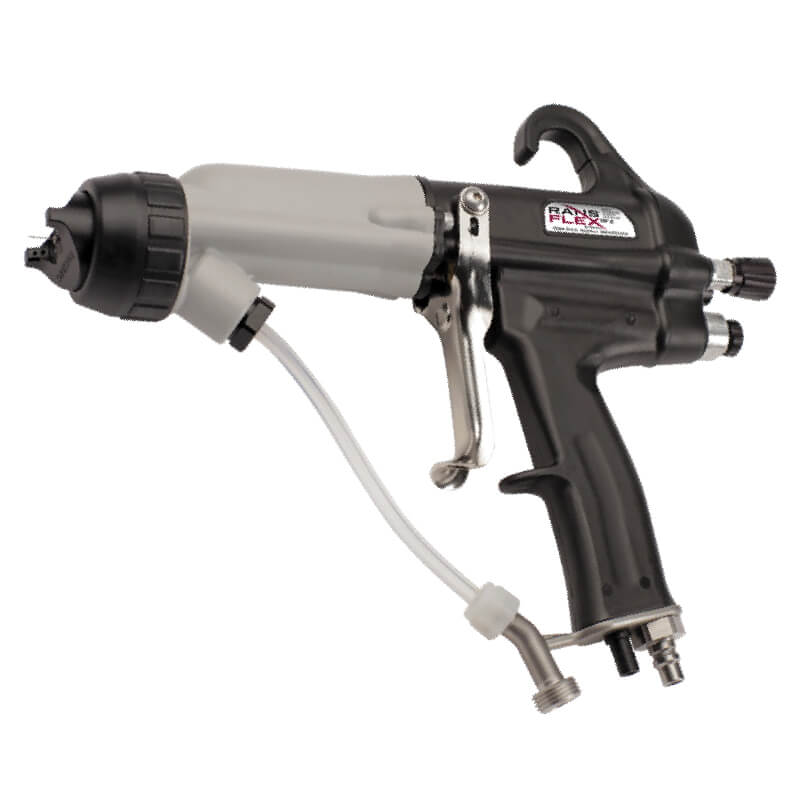
Ransburg RansFlex Main Features
- Ergonomic fit, feel, balance and controls
- Superior atomization and performance
- Sleek and smooth exterior
- Stylized, user friendly control knobs
- Quick disconnect built into gun handle (optional)
- 20% fewer parts than previous version applicators
- Removable cascade assembly
- Meets FM, FMC and ATEX approvals
- Smaller diameter fluid and air hose
- Waterborne or solventborne models available
- Waterborne models available in direct or indirect charge technology for application flexibility
- Protected Internal Components
- Divorced generator air supply cartridge protects strategic internal components
- Sealed nozzle/atomisation passages to protect internal components from solvent or fluid invasion
- Increased transfer efficiency
- Significantly increases quality and production
- Positive environmental impact
- Reduces overspray, air pollution and VOC emissions
- Decreases coating costs
- More consistent part-to-part quality
- Reduced costs for the disposal of hazardous materials
- Ergonomic fit, feel and balance
- Operators experience less stress on joints and muscles
The Ransburg RansFlex is an electrostatic spray gun made by Ransburg, a leading manufacturer of industrial finishing equipment. Overall, the Ransburg Ransflex electrostatic manual and automatic spray guns allow more efficient and cost-effective finishing while also reducing environmental impact.
What are electrostatic spray guns?
These impart an electrostatic charge to the atomized paint particles, causing them to be attracted to the grounded target surface. This results in very high transfer efficiency and minimal overspray.
They are used for overall painting and hard to reach areas. It is very common to use this technology to paint bicycles, stairs, furniture, and products like these. They require specific paint formulas, which can be powder or liquid.
1st place: DeVilbiss SGK-505-622
The DeVilbiss SGK-505-622 is a high production pressure spray guns fed by tank or pump. They provide great paint savings by reducing waste because it works with a lower air volume.
This spray gun widely used for wood finishing also features a super smooth and precise trigger, hardened stainless steel needle, replaceable air deflector with thread, ink flow through stainless steel body, also suitable for water based paints.
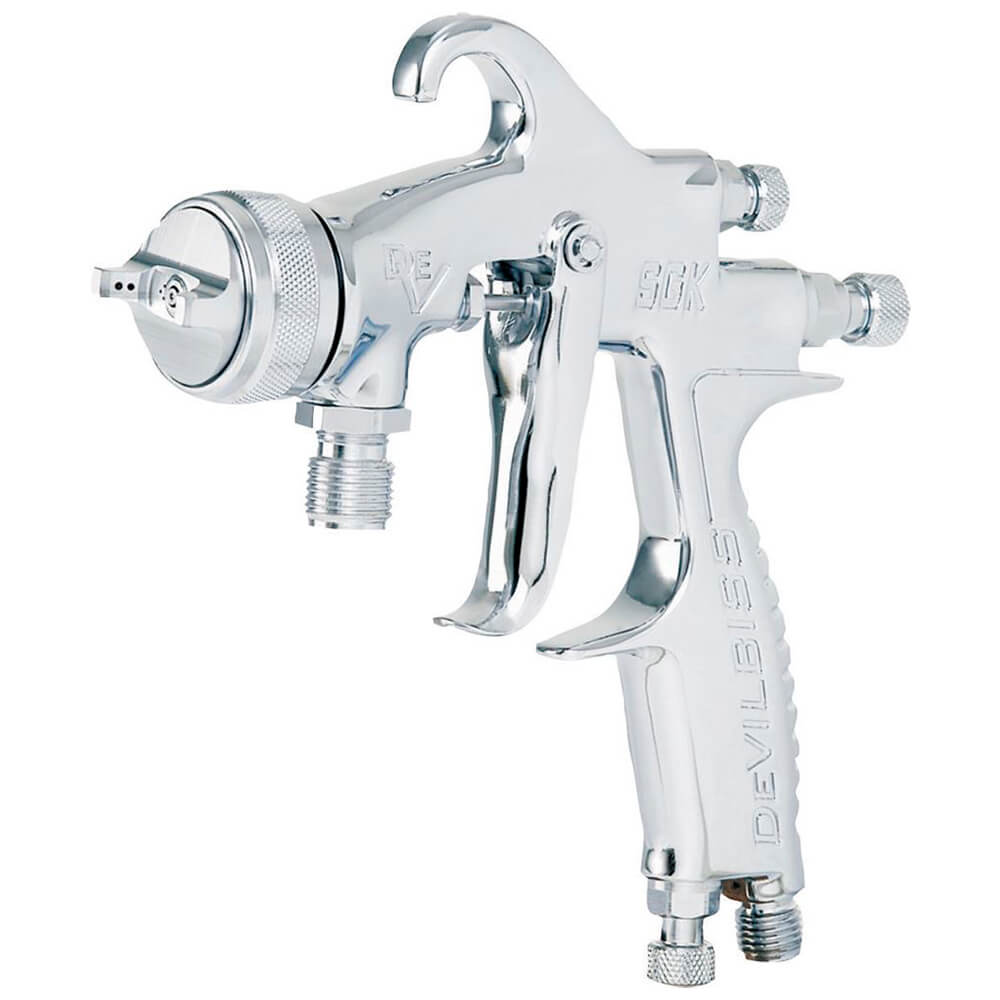
Devilbiss SGK-505-622 Main Features
- Air nozzle with HVLP-Transtec technology that provides a thinner spray and greater paint savings
- Paint bloom through the metal body
- Suitable for use with water-based paints as well
- The air valve allows to regulate the air flow with precision
- Strong, simple and practical hook makes the painter’s work easier
- Perfect and comfortable handle, innovative design, which allows a perfect balance
- Precise controls for airflow and ink flow easy to adjust
- Replaceable threaded air deflector
- Super light and precise trigger
- Excellent durability and service life
DeVilbiss SGK-505-622 Technical Features
- Nozzle / Needle: 1.1 mm (model SGK-505-622-11), 1.4 mm (model SGK-505-622-14) and 1.8 mm (model SGK-505-622-18)
- Air consumption: 11 to 13.5 CFM
- Fluid flow: 300 to 840 ml / minute
- Pressure at gun inlet: 35 to 45 PSI
- Fan size: 13″ to 16″ at a distance of 9″
How big is the wood furniture manufacturing industry in the world?
The global wood furniture manufacturing industry is quite large and generates hundreds of billions in revenue annually. So, countless spray guns for wood are going to be needed. Here are some key facts about the size and scale of the industry:
- Global revenue for wood furniture manufacturing is estimated to be around $407 billion as of 2022
- The top producing countries are China, United States, Germany, Italy, India, Vietnam, Poland, Canada and Mexico
- China accounts for over 50% of world production and exported $61 billion worth of wood furniture in 2021
- The United States wood furniture market was estimated at $27 billion in 2021
- The industry in the United States employs over 400,000 people across more than 11,000 businesses
- The top U.S. states in wood furniture manufacturing are North Carolina, California, Michigan, Indiana, Texas, Wisconsin and Virginia
- Global production is estimated at over 600 million pieces annually and projected to grow to $583 billion by 2027
- Demand is driven by rising incomes, population growth, new housing construction and trends like customizable and multi-functional furniture.
So, in summary, it is a massive global industry producing hundreds of billions in furniture annually across thousands of manufacturers. The growth and demand for wood furniture is expected to continue rising steadily in the coming years. More and more equipment for wood finishing is going to be needed as well.
What spray guns for wood suits you better?
Most likely, one of the options shown here will fir your needs perfectly. Still, there might be more to consider to decide. We understand that getting the right industrial finishing equipment might be a daunting task, facing all the options available.
Nevertheless, you are not alone. Any of our experts can help you out, not only to define what spray gun for wood you might need, but to set up a complete industrial finishing operation. Feel free to contacts us anytime.

